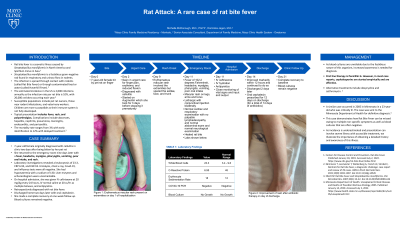Back

Clinical: General Topics
Rat Attack: A rare case of rat bite fever
Friday, March 31, 2023
12:00 PM East Coast USA Time


Michelle McDonough, MD
Resident Physician
Mayo Clinic Family Medicine Residency Program - Mankato
Eagle Lake, Minnesota, United States
Presenting Author(s)
Introduction: Rat bite fever is a rare zoonotic illness caused by Streptobacillus moniliformis, a fastidious bacteria found in rodents. This case illustrates the rare diagnosis of rat bite fever with the goal of increasing awareness of its presentation. It stresses the importance of obtaining a detailed history as this unique disease is hard to diagnose due to the fastidious nature of the causative organism and missed diagnosis can lead to dire consequences.
Case Study: A 7-year-old female presented to clinic two days after being bitten by her pet rat with finger pain, erythema, and reduced flexion. She was diagnosed with cellulitis but had poor compliance with antibiotics. She returned to the emergency room nine days later with a fever of 102.2 degrees F, headache, myalgias, pharyngitis, vomiting, poor oral intake, and erythematous macular rash of the extremities. She was lethargic with conjunctival injection bilaterally. Cardiac, respiratory, and abdominal examination was unremarkable. Her rat bite had healed. Kernig’s and Brudzinski’s signs were negative. Differential included sepsis secondary to prior cellulitis, meningitis, and rat bite fever.
Workup revealed a leukocytosis of 23.3, CRP 6.95, and ESR 18. Urinalysis, chest x-ray, Covid-19, and influenza tests were all negative. Liver enzymes and echocardiogram were unremarkable.
She was given ceftriaxone, IV fluids, and antipyretics. She improved within 12 hours. She remained afebrile and was discharged with cephalexin. Blood cultures remained negative, as expected due to the fastidious nature of Streptobacillus moniliformis. Rat bite fever was the leading cause with history of rat bite, characteristic symptoms, and negative Kernig and Brudzinski.
Discussion: Typical presentation includes fever, rash, and polyarthralgias. The mortality rate ranges from 3% with early identification to 12% with delayed treatment. Blood cultures are unreliable due to the fastidious nature of this organism. First line therapy is Penicillin G. In most case reports, cephalosporins are started empirically and are effective. Alternative treatments include doxycycline and azithromycin.
This case differed from prior case reports as she lacked arthralgias had received partial antibiotic therapy. Rat bite fever can be missed owing to multiple nonspecific symptoms as well as blood cultures that are often negative. As incidence is underestimated and presentation can involve severe illness with accessible treatment, we illustrate the importance of obtaining a detailed history and awareness of this illness. This case is relevant to osteopathic medicine as the diagnosis relies on a thorough history including past exposures as part of comprehensive, holistic care.
Case Study: A 7-year-old female presented to clinic two days after being bitten by her pet rat with finger pain, erythema, and reduced flexion. She was diagnosed with cellulitis but had poor compliance with antibiotics. She returned to the emergency room nine days later with a fever of 102.2 degrees F, headache, myalgias, pharyngitis, vomiting, poor oral intake, and erythematous macular rash of the extremities. She was lethargic with conjunctival injection bilaterally. Cardiac, respiratory, and abdominal examination was unremarkable. Her rat bite had healed. Kernig’s and Brudzinski’s signs were negative. Differential included sepsis secondary to prior cellulitis, meningitis, and rat bite fever.
Workup revealed a leukocytosis of 23.3, CRP 6.95, and ESR 18. Urinalysis, chest x-ray, Covid-19, and influenza tests were all negative. Liver enzymes and echocardiogram were unremarkable.
She was given ceftriaxone, IV fluids, and antipyretics. She improved within 12 hours. She remained afebrile and was discharged with cephalexin. Blood cultures remained negative, as expected due to the fastidious nature of Streptobacillus moniliformis. Rat bite fever was the leading cause with history of rat bite, characteristic symptoms, and negative Kernig and Brudzinski.
Discussion: Typical presentation includes fever, rash, and polyarthralgias. The mortality rate ranges from 3% with early identification to 12% with delayed treatment. Blood cultures are unreliable due to the fastidious nature of this organism. First line therapy is Penicillin G. In most case reports, cephalosporins are started empirically and are effective. Alternative treatments include doxycycline and azithromycin.
This case differed from prior case reports as she lacked arthralgias had received partial antibiotic therapy. Rat bite fever can be missed owing to multiple nonspecific symptoms as well as blood cultures that are often negative. As incidence is underestimated and presentation can involve severe illness with accessible treatment, we illustrate the importance of obtaining a detailed history and awareness of this illness. This case is relevant to osteopathic medicine as the diagnosis relies on a thorough history including past exposures as part of comprehensive, holistic care.
